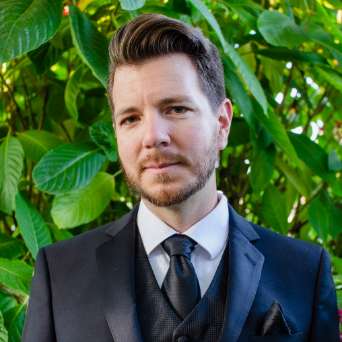A major orchestra programming a complete opera “fully staged” would understandably come with a caveat. After all, how do you stage an opera in a concert hall? The Los Angeles Philharmonic, which has performed several complete operas with various degrees of staging throughout the tenure of Artistic Director Gustavo Dudamel, added another to its repertoire with their first staged Das Rheingold in Walt Disney Concert Hall as part of their 20th anniversary celebration of Frank Gehry’s magnificent design. Gehry himself designed the impressive transformation of one of the great concert halls of the world to an opera house (for at least a few nights). Thursday’s performance was a beguiling demonstration of the space but, even more crucially, a fine display of the potency of one of the world’s great orchestras.
Richard Wagner understood the vital role the orchestra plays in portraying the drama in opera. Yet he insisted that the on-stage dramatic component was to be the sole visual focus to the point that the composer perfected the art of hiding the orchestra in his festival theater at Bayreuth. It seems counterintuitive then for the dramatic focus of a fully staged performance to place the orchestra front and center, but it was, occupying its normal position. Gehry cleverly built the stage above them, with the platform recessed into the area that would have been the choir stalls. It made for a tall visual landscape. Several vertical fabrics were used for scenic projections and supertitles to make the space even taller with a significant number of the audience looking up to the “stage” or even to their side. Gehry added other dimensions by using the even higher plane of the organ platform and adding a much lower (eye-level) proscenium in front of the orchestra. It was a good use of the space and director Alberto Arvelo was only too happy to use every inch.
The creative team’s setting was non-specific and straightforward in its portrayal of the action. The Rhinemaidens were portrayed in an aquatic environment, dressed in flowing blue and green fabrics, Alberich was a scaly wretch, clouds floated above Valhalla. Cindy Figueroa's costumes were fused with futuristic elements that also harkened back to ancient times. Colors reflected their characters (Loge had flowing red hair, Freia in sparkly gold). The projections on the wrinkled fabrics often portrayed abstract textures of nature (water, earth, clouds). More vital was the lighting of Rodrigo Prieto which set the atmosphere as well as location. The more fantastical elements of the story (Alberich’s sorcery, for example) required more suspension of disbelief by the audience than usual. The cast of singers made this an easier task than one would imagine.
The LA Phil assembled a relatively young, dynamic, diverse cast who were all too eager to sink their teen into the mythical characters. They were led by Ryan Speedo Green’s Wotan. An imposing, statuesque figure, Green was stern and stubborn as the wandering god. His large bass-baritone was powerful and resilient. Raehan Bryce-Davis was a knowing and fierce foil as Fricka. Her high mezzo-soprano sound is piercing while remaining noble. Simon O’Neill (once a notable Siegfried) was a fine fit for Loge. He leaned into the haughty character’s scheming with his bright tenor. Jessica Faselt was one of the vocal standouts of the evening as Freia, already a Wagnerian soprano to be reckoned with.
Jochen Schmeckenbecher was a detestable and dynamic Alberich, the most convincing character portrayal of the evening. Morris Robinson was a powerful Fasolt, and Tamara Mumford a moving and noble Erda. There wasn’t a weak vocal link among the cast.
Yet I found myself often turning my focus to the orchestra, partially because they were front and center, but primarily because under Gustavo Dudamel they were an illuminating force. Dudamel’s reading of the score was, on the surface, straightforward, but the orchestra performed Wagner’s intricate textures with ultimate clarity. There was no moment when the balance was off between singers and orchestra, no moment when the orchestra was bombastic. The music flowed in a chamber-like gracefulness between singers and orchestra, revealing Wagner’s meticulous details. Of course, the orchestral sound was still often thrilling (off-stage anvils marking the descent into Nibelheim were from the highest rafters) and the gods’ entrance to Valhalla was as stirring as one would hope. This performance was a noteworthy achievement for the LA Phil and Dudamel. One hopes the conductor will continue to bolster his impressive operatic credentials by bringing Die Walküre to Disney from the Hollywood Bowl while we still have a few years left with him. For the LA Phil and Dudamel together, as Erda warns, “Alles was ist, endet”.




